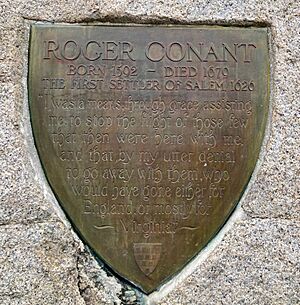Roger Conant (colonist) facts for kids
Quick facts for kids
Roger Conant
|
|
|---|---|

Statue of Roger Conant by Henry Hudson Kitson in Salem, Massachusetts.
|
|
| Born | c. April 1592 East Budleigh, Devonshire, Kingdom of England
|
| Died | November 19, 1679 (aged 87) |
| Occupation | Colonist, drysalter |
| Known for | Founding Salem, Massachusetts |
Roger Conant (born around April 9, 1592 – died November 19, 1679) was an important early colonist in New England. He is famous for helping to start the communities of Salem, Peabody, Beverly, and Danvers, Massachusetts. During his lifetime, Peabody, Beverly, and Danvers were all part of Salem.
Conant arrived in Plymouth Colony from London in 1624. He later became a leader for people who disagreed with some of the rules in Plymouth. He led them to new areas, including a place where Native Americans, called the Naumkeag people, had a village and trading center. This place later became Salem.
Roger Conant's strong leadership helped the new settlement in Salem survive its first two years. However, John Endecott, a new arrival, was chosen by the Massachusetts Bay Company to replace him as governor. Conant kindly stepped aside. He was given 200 acres (about 0.81 square kilometers) of land as a thank you.
Conant passed away in Beverly, Massachusetts Bay, on November 19, 1679.
Contents
Early Life and Journey
Roger Conant was baptized in a town called East Budleigh in Devon, England, on April 9, 1592. His parents were Richard and Agnes Conant. Later, he moved to London and became a drysalter. A drysalter was someone who sold or dealt with chemicals, dyes, and other dry goods.
Conant is believed to have arrived in Plymouth Colony in 1624. Some records suggest his brother, Christopher Conant, arrived earlier in 1623.
Leading the Way in New England
After arriving in Plymouth, Conant found that some people were unhappy with the way things were run. He decided to look for other places where people could live and worship more peacefully. He moved to fishing and trading outposts along the New England coast, first at Nantasket and then at Cape Ann.
Founding Salem
Around 1624, Conant moved his family to Nantasket. About a year later, they moved to Cape Ann, which is at the northern end of Massachusetts Bay.
In 1626, the English settlers on Cape Ann chose Roger Conant as their first governor. This group soon moved from Gloucester to what is now Salem. This new settlement was the first permanent English community in the Massachusetts Bay Colony. It was also where the first official government was set up in the colony.
Conant first lived in a large house in what is now Stage Fort Park in Gloucester. In 1628, Governor Endecott had this house moved to Salem. Later, during the American Civil War, an old fort in Gloucester was renamed Fort Conant in Roger Conant's honor.
Later Years and Legacy
Roger Conant built the first house in Salem on what is now Essex Street. In 1630, he became a "freeman," which meant he was a voting member of the Massachusetts Bay Company.
Conant was one of the first two representatives from Salem to the colony's main law-making group, called the General Court. The people of Salem also elected him many times to be a "selectman," which was like a town council member. When communities were allowed to set up local courts, Roger Conant served on juries in Salem for sixteen years. He also helped with important town tasks, like setting up town borders and giving out land grants.
Roger Conant stayed active in Salem's affairs throughout his long life. In 1639, he was one of the first people to sign the contract to make the meeting house bigger for the First Church in Salem. This important document is still part of the town records today.
Roger Conant's Family
Roger Conant married Sarah Horton in London on November 11, 1618. They had nine or ten children together. Sarah was alive in 1660, but she likely passed away before 1678. Her burial place is not known.
Some of their children included:
- Sarah (born 1619, died 1620)
- Caleb (born 1622, died before 1633)
- Lot (born around 1624, died 1674). He married Elizabeth Walton and had ten children.
- Roger (born in Salem, died 1672). He married Elizabeth Weston and had two children.
- Sarah (born around 1628). She married John Leach and had ten children.
- Joshua (born around 1630, died 1659). He married Seeth Gardner and had one son.
- Mary (born around 1632). She married John Balch and later William Dodge.
- Elizabeth (born around 1635).
- Exercise (baptized 1637, died 1722). He married Sarah Andrews and had six children.
Death and Burial
Roger Conant died on November 19, 1679, in what is now Beverly, Massachusetts. He is believed to be buried in Burying Point Cemetery in Salem.
His Statue in Salem
In 1913, the Conant Family Association approved a design for a bronze statue of Roger Conant. The sculptor was Henry Hudson Kitson. The statue shows Conant wearing a large, flowing cloak and a wide-brimmed hat, looking out over Salem Common. It stands on a large rock from nearby Lynn, Massachusetts.
Because of his cloak and hat, and because the statue is right outside the Salem Witch Museum, many visitors sometimes mistake Roger Conant for a witch!
In 2005, a local neighborhood group raised money to clean and restore the statue. The $30,000 restoration helped remove stains caused by acid rain and pollution.
A plaque on the front of the statue has a quote from Roger Conant: "I was a means through grace assisting me to stop the flight of those few that then were here with me, and that by my utter denial to go away with them, who would have gone either for England, or mostly for Virginia." This quote shows how determined he was to stay and build the new settlement.




